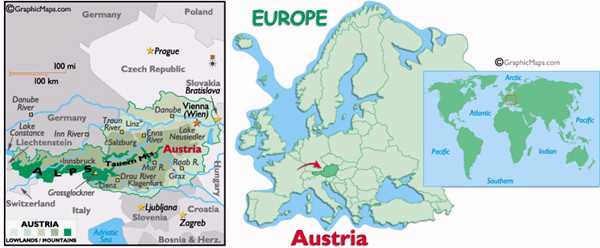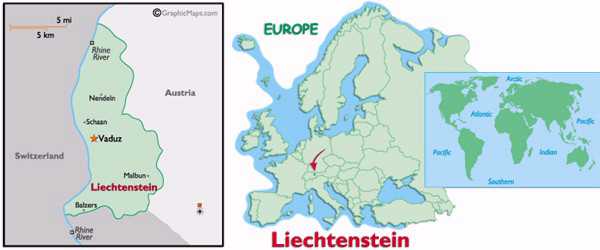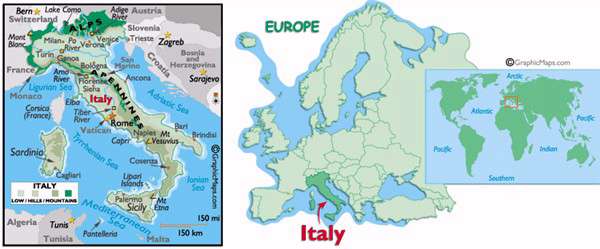In August 2010 I flew to Austria for 3 weeks. I ended up visiting the countries of Austria, Liechtenstein, Italy, Hungary, and the Slovak Republic (Slovakia). My main focus was going to be Austria with a plan of traversing the country west to east with some north zigs and south zags (or is north a zag and south a zig?). But before I left I knew I would spend 3 nights in Bratislava, Slovakia and about the same in Liechtenstein. I also knew I was going to spend a short stay in Hungary, just how short I wasn’t sure. Italy for a night was just thrown in because I was hungry and I didn’t want to backtrack on my drive. Now hang on for the ride.
I actually spent my first 3 nights in the beautiful, but compact Principality of Liechtenstein. This was not the first time I had been here, and I have the passport stamps to prove it. The Principality is nestled between Switzerland and Austria so it enjoys some tremendous (albeit only a little bit of) scenery. I stayed in the town of Schellenberg, which is not far from the capital of Vaduz. Of course, in Liechtenstein nothing is far from Vaduz. I spent some time in Liechtenstein, but I also used it as a base for exploring several towns and areas along the western Austria border.
The western half of Austria, the Tirol Region, is very narrow with a lot of scenery revolving around the Alps. This narrowness made it easy since there are only so many roads going through the area. I started in the town of Bregenz along the Bodensee (Lake Constance). The Old Town is very nice, and it is only a short walk to the serene water front where you can catch a cruise to Switzerland or Germany (I suppose that’s if you tire of Austria). Nearby is the Bregenzerwald (Bregenz Forest) with the Alps as the backdrop and colorful villages like Schwarzenberg, Bezau, and Hohenems. Not to be out done is the Grosswalsertal (Great Walliser Valley) with its scenic drive and many switchbacks from Damüls to Bludenz. This then leads to the Brand Valley and the town of Brand, with the largest lake in the Alps, Lünersee. Did I mention all of this is just within 50 miles of Bregenz and the western border of Austria? I still have more traveling east.
If you haven’t guessed it (or read any of this story except this sentence) this is Alp country, so there are a lot of ski resorts and ski towns. But hey, this is summer so that means spectacular scenic drives, silent serene villages, and stunning scenery in a short sleeved shirt. One of these villages is Ischgl in the Paznaun Valley which has a 2.5 mile cable car run to 7,500 feet and is dominated by the Fluchthorn at 10,462 feet. Nearby is the town of Landeck and the 13th century Burg Landeck Castle over shadowing the city and the Inn River. Heading a little further east and south along the Ötzal Valley (I’m getting to Italy soon) is the town of Sölden complete with a ski lift to 9,800 feet and the Rettenbach Glacier.
The Ötzal Valley drive south of Sölden becomes the Timmelsjoch mountain pass in Austria and once it crosses into Italy it becomes the Passo del Rombo. What must go up must come down. Looking at the map, I saw I could loop into Italy and take another mountain pass, the Passo di Monte Giovo, and eventually end up taking Brenner Pass back to Austria. It was a sieg/vittoria situation (that’s win/win in German/Italian). It was a great drive. The towns along the way in this part of Italy really are more Germanic than Italian. Towns like St. Leonardo, Vipiteno, and Colle Isarco all have equivalent Germanic names of St. Leonhard, Sterzing, and Gossensass. This is the Tyrol part of Italy and the German language is as prominent as Italian, but that doesn’t stop them from eating Italian. I had some molto buono pizza and delizioso gelato as long as I was there in Italy.
A short drive north from Italy through the Brenner Pass brings you back to Austria and eventually to Innsbruck. Despite being a fairly large city (about 120,000 people) it does have spectacular Alps scenery surrounding it, including the Inn River and the somewhat un-dramatic bridge from which the city got its’ name. Once you find a place to park, the Altstadt (Old City) has wonderful pedestrian zones to wander in and is easily done by foot. Just a short drive away from Innsbruck is the town of Wattens, where the Swarovski Crystal is made. While they have frequent tours available, I was disappointed it wasn’t a behind the scenes tour of the facility but it was more of an art exhibit (I expected at any minute to see a beatnik come out beating a bongo and reciting prose). Following east along the Inn River, there were a couple medieval towns worth seeing. Rattenberg is right along the Inn River and has narrow cobbled streets that all seem to lead there. Over shadowing the town are ruins of an Emperor Maximilian’s castle. A little further away in Kufstein, Maximilian captured from Bavaria Festung (Fortress) Kufstein in 1504. That Max dude did a great job at giving these towns that medieval look and feel.
Not much farther east is Salzburg. This city has a tremendous history, great sites, and a lot to see. Despite its’ apparent size, almost everything you need to see is within walking distance of each bank of the River Salzach (and that includes walking up to Salzburg Fortress). There are phenomenal views of the city both from the Salzburg Fortress (the left bank) and the Kapuzinerberg Hill (the right bank). There are some great places to see just outside of Salzburg, but I’ll get back ‘round to these at the end. For now I’m heading south of Salzburg.
Driving south of Salzburg is the town of Zell am See. Here you can catch a boat, rail, or any number of cable car lifts to get to panorama vistas of the area. This is not to say you have to leave the town to see something. You can stroll the streets in town and see a number of buildings built in the 1200 and 1300’s or grab a bench along the water and enjoy the scenery, people watching, and maybe an ice cream. But what really makes this area special is that this town is very near the start of the Grossglocknerstrasse (Großglockner Highway). This is a spectacular 48 kilometre highway through the Alps and includes views of the highest point in Austria, Grossglockner Mountain at 12,470 feet. The road itself elevates to 8,370 feet and also passes through the Hohe Tauern National Park. To top it all off is the Pasterze Glacier, the longest glacier in Austria at 5.2 miles.
After all the Alp scenery of the dramatic Grossglocknerstrasse, it was bound to happen. I ran into the foot hills. While traveling along the central southern edge of Austria (near the Slovenian border) the Alps give way to rolling hills, scenic pastures, and some quaint villages. One of the larger towns in this area is Villach, which still retains much of the old world charm because of the compact old town. One of my guide books had said the church in Maria Wörth on the Wörther See was one of Austria’s most photographed sites. This is why you have to see things for yourself, I had seen better sites. Actually, not far from there was one of these. The 13th Century Hochosterwitz Castle majestically rises up and dominates the landscape as you approach. It is very impressive to look at and was the inspiration for Disney’s Sleeping Beauty Castle. The actual castle insides is nothing more than a restaurant and museum of medieval armor and weapons, the impression it gives as you approach is the main attraction. You can look at the pictures of the 2 and make your own decision as to which is better.
Nearing the southeast corner of Austria is the city of Graz. I was looking forward to this since they had a great real-time webcam and I could call home and be seen on the webcam. But first, I had to see the sites. Graz reminded me a lot of Salzburg, just a similar look and feel. While the Schloss Eggenberg (castle) is actually outside of town, it does have Schlossberg (Palace Mountain) that provides a panorama of the city. It is also easy to walk around to see, but with not as many sites as Salzburg. I proceeded to the Hauptplatz (Main Square) and was able to call home and be seen on the webcam. How cool is that? By the way, Arnold Schwarzenegger was born just outside of Graz in Thal. About 10 miles outside of Graz is Das Österreichische Freilichtmuseum (The Austrian Open Air Museum). They picked an idyllic location in Stübing to place about 80 buildings from all parts of Austria. Many of these are working buildings showcasing the skills from days gone by. I have said it before, if you can go to an open air museum it really is something that shouldn't be missed. I started driving to the northeast corner of Austria toward Vienna (Wien). There were several towns South of Vienna I wanted to stop at to see castles, such as Eisenstadt, Mödling, and Marchegg. But before Vienna, it was on to Hungary.
I had read in a tour book about a border crossing between Mörbisch, Austria and Hungary that had no passport control. It sounded interesting as the only way to get to Hungary was to walk across the border. The book had described walking in the woods, then about 50 metres in you see the border sign for Hungary. I thought 'Why not?’. Odd thing about the book description, it did not describe what it was really like. First off, the Austrian towns very near the Hungary border (such as Mörbisch and Rust) have a distinct look about them. They don't have the colorful Austrian buildings; they are instead stark white and seem very totalitarian. Then when I parked at the end of the road, there were a number of cars, but no people. At the border on the Hungary side there were a couple mini-cabs. Since I didn’t know where they went, I decided to walk. As I walked deeper and deeper into the woods, I expected the trees to start talking and throwing apples at me (I knew I wasn't in Kansas anymore). Eventually the woods opened up and I could see some of the country side and the Hungarian town of Fertőrákos in the distance. Civilization; as defined by a small Hungarian town. I found out later it was only about a mile and half walk. After roaming the town for a short time I took a mini-cab back to the border (for €1). My latest adventure in Hungary was over.
In Vienna, Austria I was going to take the Twin City Liner (75 minutes) on the Danube River to Bratislava, Slovakia (the country's capitol). I had done research ahead of time and mapped the dock locations along with the boat schedule. Now I just had to execute the plan at the right time. When I was getting near Vienna I reserved my boat ticket and hotels in Vienna and Bratislava. I was on my A-Game. I love it when a plan executes successfully to completion (or something like that). Approaching Bratislava, I took a whole lot of pictures and had not even left the boat. After walking to my hotel from the dock, I dropped off my luggage and proceeded toward Hlavné námestie (The Old Town Square). I was surprised by how many residents spoke English and that even the tourist signs were in English. I asked a local about this and found out English is taught in their schools and other foreign languages are optional. The other surprise was the lack of crowds, not only people but traffic. I took some video and pictures and there is very little traffic. Most everyone walks or uses public transportation. The tourist signs in English made it easy to get around and see the sights. The prices for food and souvenirs were very cheap by European standards. It is a very photogenic city, and they have a lot to see.
When I returned to Vienna from Bratislava, I thought I would spend a couple days there since it had been a number of years since I was here before. But after all the places I had been to for nearly 3 weeks, the crowds, the noise, and the traffic was just too much. Vienna is the largest city in Austria, and the surrounding area has 25% of the whole country’s population with about 2.3 million people. Fortunately, when I arrived on the boat from Bratislava I was near the historic part of Vienna. I saw some of the highlights and spent about 6 hours there. Maybe next time I’ll start in Vienna and work my way out.
I was now heading back west of Vienna toward Salzburg again (I told you earlier I’d get back there). Along the Danube River is the Melk Abbey built in 1089 but, rebuilt in 1736 due to a fire. The location makes it difficult to capture a photo of how large it is. At least I was there in the afternoon, which provides the best sunlight on the abbey for capturing the brilliant coloring on the building. There were actually quite a few towns (like Maria Taferl and Grein) as I drove along the Danube that had great views with castles. Another good example is Clam Castle in the wonderfully picturesque town of Klam (OK, it’s not exactly on the Danube, but it is close).
Finally, east of Salzburg is Salzkammergut (The Lake District). There are many towns in this area perched on the shores of lakes. Towns such as Gmunden, Mondsee, and St. Wolfgang are in this area but the best known is probably Hallstatt. While the area is worth coming to see, to me Hallstatt was way too crowded for my liking. I found the towns along the way to be as scenic but, the tour buses (loads of tourists) pass them by to get to Hallstatt.
I’ve gone full circle around Austria now. Thanks for hanging in there and now the bad news. For as long as the story was, there is an appropriately matching number of pictures for you to look at. Enjoy.











































































